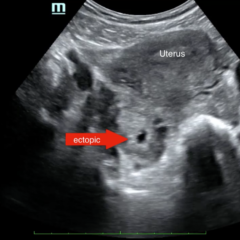An Elderly Male with Amyand’s Hernia
History of present illness:
A 67-year-old male, with a history of diabetes, coronary artery disease, and chronic kidney disease, presented with two weeks of a new right inguinal bulge and right lower quadrant abdominal pain extending to the groin. He denied nausea, vomiting, fever, and changes in bowel movement. His initial vital signs were: temperature 37.4°C, blood pressure 142/100, heart rate 62, and respiratory rate 18. Physical examination revealed mild right lower quadrant abdominal tenderness, right inguinal and testicular tenderness and swelling, and a non-reducible bulging inguinal mass with no overlying skin changes. Lab results showed a leukocytosis of 13.6×103/mm3.
Significant findings:
Ultrasound of the right scrotum shows a right inguinal hernia with an air-containing loop of bowel (white arrow) and a non-compressible appendix (yellow arrow). Coronal and axial views of abdomen-pelvis CT show a right inguinal hernia containing a loop of small bowel (white arrow) and appendix (yellow arrow).
Discussion:
In the case presented above, ultrasound and abdomen and pelvis computed tomography (CT) showed an Amyand’s hernia. The patient was taken emergently to surgery, which revealed an incarcerated right inguinal hernia with perforated appendicitis in the hernia sac. The patient underwent an appendectomy and hernia repair, and had no post-surgical complications.
Amyand’s hernia is a form of inguinal hernia characterized by the presence of the appendix in the hernia sac. The hernia may be reducible, incarcerated, or strangulated; and the appendix may be normal, inflamed, or perforated.1 The patient presented above had an incarcerated hernia with no overlying skin changes suggestive of strangulation. Amyand’s hernia accounts for 0.4-1% of all inguinal hernias and 0.1% of all cases of appendicitis.2 It is thought to be due to patency of the processus vaginalis, and as such occurs more frequently in young children.1,2,3 Clinical diagnosis of Amyand’s hernia is challenging as it presents with non-specific signs and symptoms: inguinal swelling and pain, fever, vomiting, ileus, and abdominal pain.1 Consequently, ultrasound and/or computed tomography are useful in making the diagnosis.3,4 Ultrasound alone can be diagnostic and will show a non-compressible blind-ended tubular structure within the hernia sac. CT, however, is more sensitive and allows for direct visualization of the appendix entering the inguinal canal.2,3,4 Potential complications include perforation of the inflamed appendix, peri-appendicular abscess, peritonitis, orchitis, epididymitis, necrotizing fasciitis of the abdominal wall, and gangrenous appendicitis secondary to strangulation of the hernia sac.2,4 Treatment consists of hernia repair and possible appendectomy. Appendectomy and pre- and post-operative antibiotics are recommended in cases of an inflamed, perforated, or gangrenous appendix.5
Topics:
Amyand’s hernia, inguinal hernia, appendicitis, appendix, abdominal pain.
References:
- Cigsar EB, Karadag CA, Dokucu AI. Amyand’s hernia: 11 years of experience. J Pediatr Surg. 2016;51(8):1327-9. doi: 10.1016/j.jpedsurg.2015.11.010
- Michalinos A, Moris D, Vernadakis S. Amyand’s hernia: a review. Am J Surg. 2014;207(6):989-95. doi: 10.1016/j.amjsurg.2013.07.043
- Guler I, Alkan E, Nayman A, Tolu I. Amyand’s hernia: ultrasonography findings. J Emerg Med. 2016;50(1):e15-7. doi: 10.1016/j.jemermed.2015.07.042
- Vehbi H, Agirgun C, Agirgun F, Dogan Y. Preoperative diagnosis of Amyand’s hernia by ultrasound and computed tomography. Turk J Emerg Med. 2016;16(2):72-74. doi: 10.1016/j.tjem.2015.11.014
- Sharma H, Gupta A, Shekhawat NS, Memon B, Memon MA. Amyand’s hernia: a report of 18 consecutive patients over a 15-year period. Hernia. 2007;11(1):31-5. doi: 10.1007/s10029-006-0153-8





